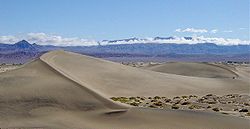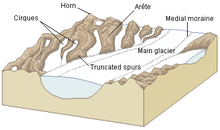Geomorphology

Geomorphology (from Greek: γῆ, ge, "earth"; μορφή, morfé, "form"; and λόγος, logos, "study") is the scientific study of landforms and the processes that shape them. Geomorphologists seek to understand why landscapes look the way they do: to understand landform history and dynamics, and predict future changes through a combination of field observation, physical experiment, and numerical modeling. Geomorphology is practiced within geography, geology, geodesy, engineering geology, archaeology, and geotechnical engineering. Early studies in geomorphology are the foundation for pedology, one of two main branches of soil science.
Landforms evolve in response to a combination of natural and anthropogenic processes. The landscape is built up through tectonic uplift and volcanism. Denudation occurs by erosion and mass wasting, which produces sediment that is transported and deposited elsewhere within the landscape or off the coast. Landscapes are also lowered by subsidence, either due to tectonics or physical changes in underlying sedimentary deposits. These processes are each influenced differently by climate, ecology, and human activity.
Practical applications of geomorphology include hazard assessment including landslide prediction and mitigation, river control and restoration, and coastal protection.
History
Perhaps the earliest one to devise a theory of geomorphology was the polymath Chinese scientist and statesman Shen Kuo (1031-1095 AD). This was based on his observation of marine fossil shells in a geological stratum of a mountain hundreds of miles from the Pacific Ocean. Noticing bivalve shells running in a horizontal span along the cut section of a cliffside, he theorized that the cliff was once the pre-historic location of a seashore that had shifted hundreds of miles over the centuries. He inferred that the land was reshaped and formed by soil erosion of the mountains and by deposition of silt, after observing strange natural erosions of the Taihang Mountains and the Yandang Mountain near Wenzhou. Furthermore, he promoted the theory of gradual climate change over centuries of time once ancient petrified bamboos were found to be preserved underground in the dry, northern climate zone of Yanzhou, which is now modern day Yan'an, Shaanxi province.
The first geomorphic model was the geographical cycle or the cycle of erosion, developed by William Morris Davis between 1884 and 1899. The cycle was inspired by theories of uniformitarianism which were first formulated by James Hutton (1726-1797). Concerning valley forms, the cycle was depicted as a sequence by which a river would cut a valley more and more deeply, but then erosion of side valleys would eventually flatten out the terrain again, now at a lower elevation. The cycle could be started over by uplift of the terrain. The model is today considered too much of a simplification to be especially useful in practice..
Walther Penck developed an alternative model in the 1920s, based on ratios of uplift and erosion, but it was also too weak to explain a variety of landforms. Grove Karl Gilbert was an important early American geomorphologist.
Processes

Modern geomorphology focuses on the quantitative analysis of interconnected processes, such as the contribution of solar energy, the rates of steps of the hydrologic cycle, plate movement rates from geophysics to compute the age and expected fate of landforms and the weathering and erosion of the land. The use of more precise measurement technique has also enabled processes like erosion to be observed directly, rather than merely surmised from other evidence. Computer simulation is also valuable for testing that a particular model yields results with properties similar to real terrain.
Primary surface processes responsible for most topographic features include wind, waves, weathering, mass wasting, groundwater, surface water, glaciers, tectonism, and volcanism.
Fluvial
Rivers and streams are not only conduits of water, but also of sediment. The water, as it flows over the channel bed, is able to mobilize sediment and transport it downstream, either as bed load, suspended load or dissolved load. The rate of sediment transport depends on the availability of sediment itself and on the river's discharge.
As rivers flow across the landscape, they generally increase in size, merging with other rivers. The network of rivers thus formed is a drainage system and is often dendritic, but may adopt other patterns depending on the regional topography and underlying geology.
Aeolian
Aeolian processes pertain to the activity of the winds and more specifically, to the winds' ability to shape the surface of the Earth. Winds may erode, transport, and deposit materials, and are effective agents in regions with sparse vegetation and a large supply of unconsolidated sediments. Although water is much more powerful than wind, aeolian processes are important in arid environments such as deserts.


Hillslope
Soil, regolith, and rock move downslope under the force of gravity via creep, slides, flows, topples, and falls. Such mass wasting occurs on both terrestrial and submarine slopes, and has been observed on Earth, Mars, Venus, Titan and Iapetus.
Glacial

Glaciers, while geographically restricted, are effective agents of landscape change. The gradual movement of ice down a valley causes abrasion and plucking of the underlying rock. Abrasion produces fine sediment, termed glacial flour. The debris transported by the glacier, when the glacier recedes, is termed a moraine. Glacial erosion is responsible for U-shaped valleys, as opposed to the V-shaped valleys of fluvial origin.
Weathering
This results from chemical dissolution of rock and from the mechanical wearing of rock by plant roots, ice expansion, and the abrasive action of sediment. Weathering provides the source of the sediment transported by fluvial, glacial, aeolian, or biotic processes.
Tectonic
Tectonic effects on geomorphology can range from scales of millions of years to minutes or less. The effects of tectonics on landscape are depend heavily on nature of the underlying bedrock fabric wich more less controls what kind of local morphology tectonics can shape. Earthquakes can in terms of minutes submerge large extensions creating new wetlands. Isostatic rebound can acound for signifacant changes in thousand or hundreds of years, and yet can orogenies give rise to large mountain chains on which other processes then act.
Volcanic
The action of volcanoes tends to rejuvenize landscapes covering up old landforms with lava and tephra eliminating things such as glacial morphology and forcing rivers trough new paths.
Biological
The interaction of living organism with landforms can be of many different forms. In general the biologicl influence on landscape is greates at zones with temperate and tropical climate and their boundaries zones with other regions. Boundary zones include subpolar regions, the tree line and semiarid areas.
Taxonomy
Different geomorphological processes dominate at different spatial and temporal scales. To help categorize landscape scales some geomorphologists use the following taxonomy:
- 1st - Continent, ocean basin, climatic zone (~10,000,000 km2)
- 2nd - Shield, e.g. Baltic Shield, or mountain range (~1,000,000 km2)
- 3rd - Isolated sea, Sahel (~100,000 km2)
- 4th - Massif, e.g. Massif Central or Group of related landforms, e.g., Weald (~10,000 km2)
- 5th - River valley, Cotswolds (~1,000 km2)
- 6th - Individual mountain or volcano, small valleys (~100 km2)
- 7th - Hillslopes, stream channels, estuary (~10 km2)
- 8th - gully, barchannel (~1 km2)
- 9th - Meter-sized features
See also
References
This article includes a list of references, related reading, or external links, but its sources remain unclear because it lacks inline citations. (February 2008) |
- Selby, Michael John (1985). Earth's changing surface: an introduction to geomorphology. Oxford: Clarendon Press. ISBN 0-19-823252-7.
- Chorley, Richard J. (1985). Geomorphology. London: Methuen. ISBN 0-416-32590-4.
{{cite book}}: Unknown parameter|coauthors=ignored (|author=suggested) (help) - Edmaier, Bernhard (2004). Earthsong. London: Phaidon Press. ISBN 0-7148-4451-9.
- Scheidegger, Adrian E. (2004). Morphotectonics. Berlin: Springer. ISBN 3-540-20017-7.
- Needham, Joseph (1954). Science and civilisation in China. Cambridge, UK: Cambridge University Press. ISBN 0-521-05801-5.
- Kondolf, G. Mathias (2003). Tools in fluvial geomorphology. New York: Wiley. ISBN 0-471-49142-X.
{{cite book}}: Unknown parameter|coauthors=ignored (|author=suggested) (help)
Courses
- Geomorphic and Ecological Fundamentals for River and Stream Restoration: includes a listing of instructors & additional short courses in Geomorphology topics taught by this group.
External links
- International Association of Geomorphologists
- Geomorphology in the Association of American Geographers
- British Society for Geomorphology
- Association of Polish Geomorphologists
- German Geomorphologists Group (Deutscher Arbeitskreis fuer Geomorphologie
- Model of landscape evolution by William Morris Davis (by GEOMORPHLIST)
- The Geographical Cycle, or the Cycle of Erosion (1899)
- Geomorphology from Space (by NASA)
- USDA-NRCS Web Soil Survey Survey of surficial geologic deposits and geomorphology across the U.S.

